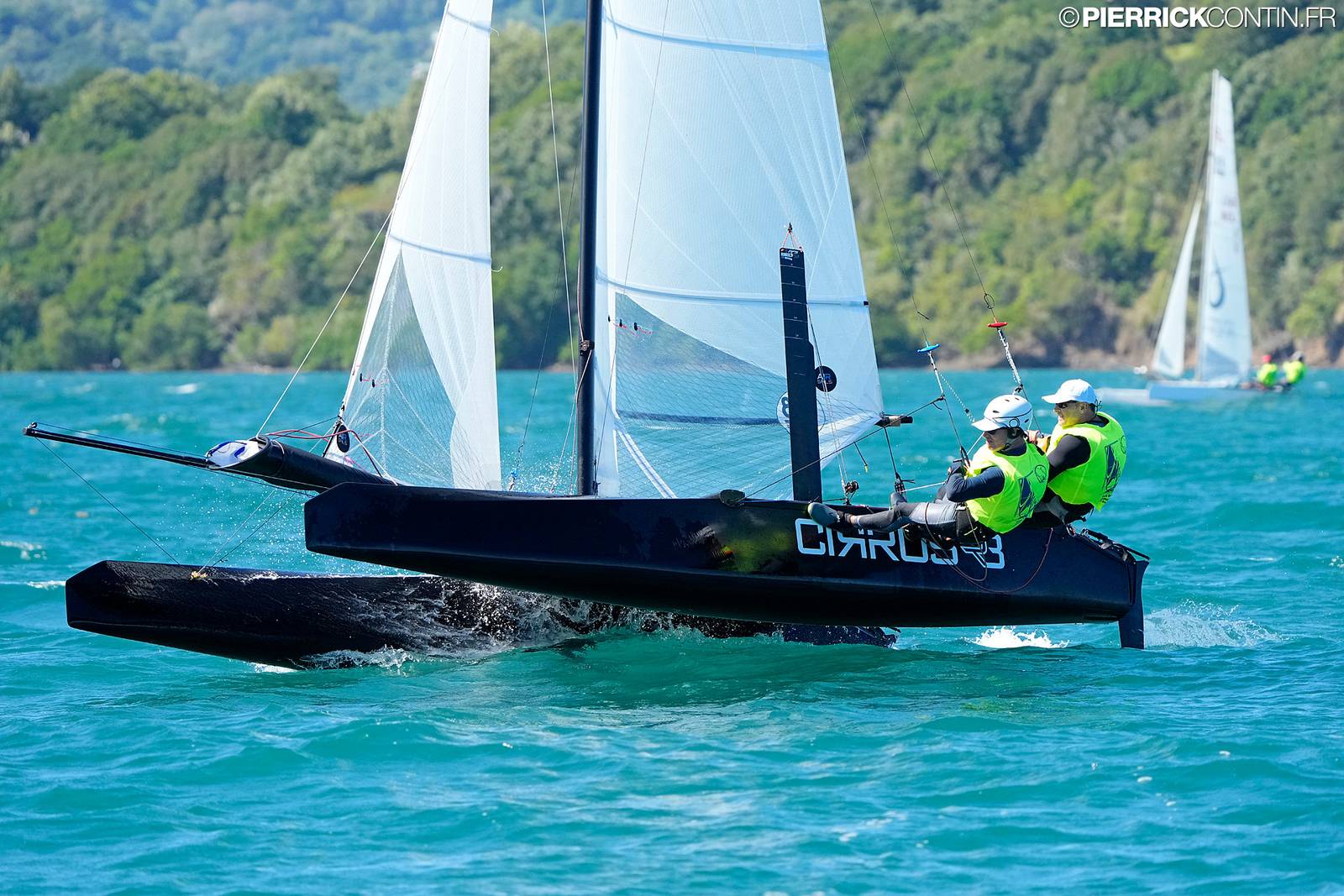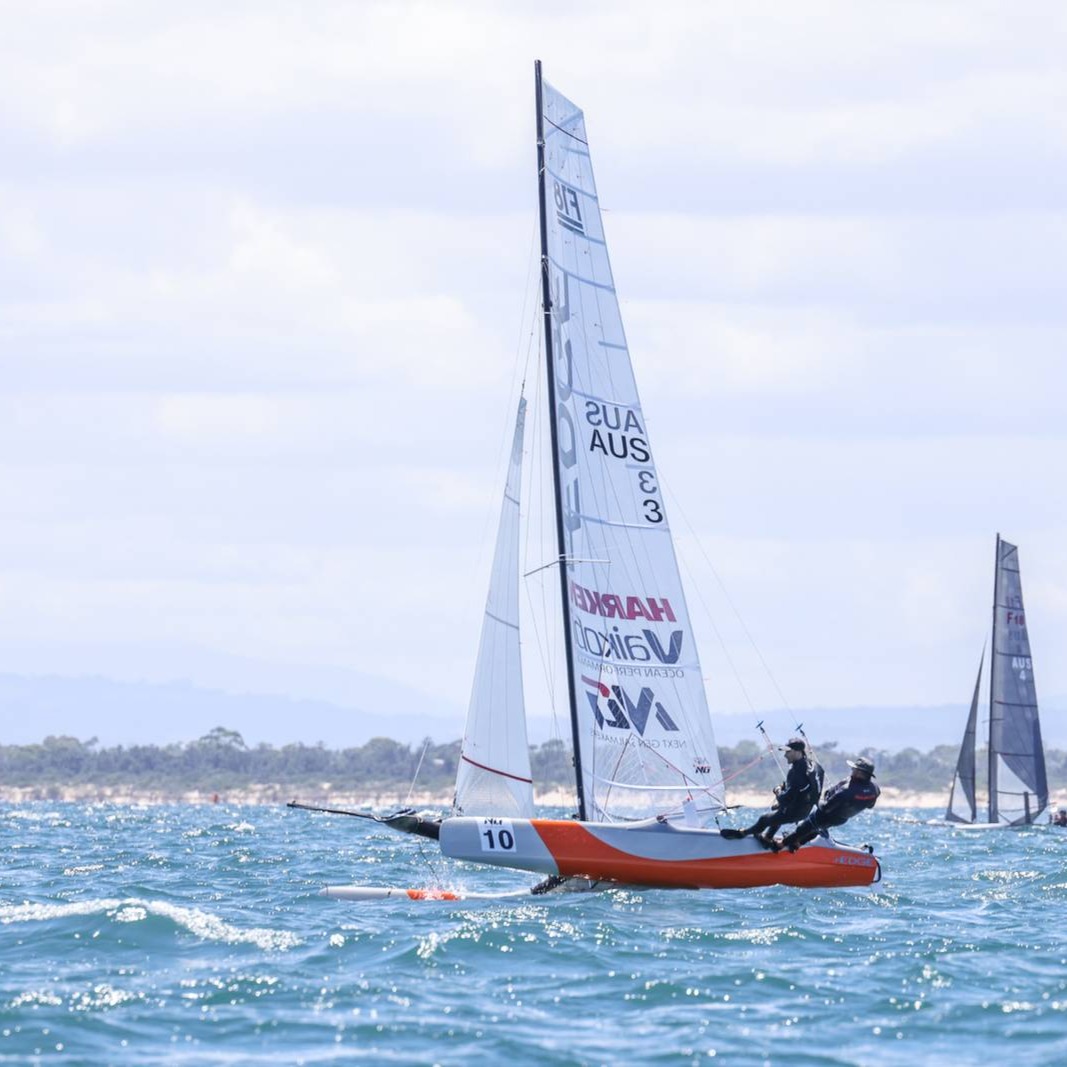The Cirrus Story by Manu Boulogne

When I got interested on the F18 and start working on the local F18 design/building project, one of the boats I looked up to was the Cirrus F18. Coming from the H16 racing, I knew we needed some good volume to push hard in such a powerful rig setup.
I read some reviews available on the internet in 2005 (not much material on those days) and I fully grabbed the high volume concept of the Cirrus. Interesting how Manu had the same process coming also from the H16.
Later in 2010 he launched a revolutionary design, the Cirrus R with some concepts now used in the big ACup leagues.
I met Manu in LA, but couldn´t get together for an interview, so I sent some questions later and he choose to reply gathering all them in a full story ( I labeled some points) on how he ended being one of the driving forces behind the leading cat racing scene.
The catamaran business it is a tough endeavour, for making money you’d better stay in the office, this is only for hard core and passionate characters like Manu and others that give 100% of their time to the sport. But this work has some unique rewards that only a few can experience, like riding & racing a boat you design & built yourself or providing more alternatives for you to chose from. There is always a story behind all our Cats. All Images Pierrick Contin.
—————–
 By Manu Boulogne, BCM Boulogne Conception Marine
By Manu Boulogne, BCM Boulogne Conception Marine
“Hi Martin,, I am very happy to have met you in LA. We didn’t have much time to talk but I know that we share the same passion for catamarans.
The Beginning
From the start of the Cirrus history in 1996, the BCM team has always been oriented towards racing performance. We have developed our Cirrus boats internally (design, process, production tools, molds and extrusion die plates). What interested me the most in this adventure was to learn how to produce these machines and hence realize our dreams!
This passion for catamarans has attracted me for the last 30 years. I spent a great deal of my childhood on two hulls with my twin brother before making the decision to get into the business. Like many amateurs start up companies, I spent, as you can imagine, countless of enriching days full of passion and to develop, with a faithful team, our Cirrus boats.
In the early days, the project was solely supported by our strong sailing background. I understood quickly from sailing on HC 16 that volume could be a critical performance factor. Our designs have always shown distinctive lines.
 In the 90’s, development work was primarily based on my sailing experience. We didn’t work with IT development tools yet . It was a feeling approach that, back then, seemed to be effective. I remember this first sailing test with my brother in December 1996! We were so happy to inaugurate together our first prototype “CIRRUS”. Surfing the first waves was breathtaking. Our Cirrus floated, planed and helm sensations were great! Although we were sailing on our own, we felt like we had just won a major championship. It was the first step …
In the 90’s, development work was primarily based on my sailing experience. We didn’t work with IT development tools yet . It was a feeling approach that, back then, seemed to be effective. I remember this first sailing test with my brother in December 1996! We were so happy to inaugurate together our first prototype “CIRRUS”. Surfing the first waves was breathtaking. Our Cirrus floated, planed and helm sensations were great! Although we were sailing on our own, we felt like we had just won a major championship. It was the first step …
Our motivation to further develop and improve our Cirrus was relentless! During this adventure, each one of us in the factory was eager to develop him/herself and to transform his/her passion into what became BCM today. Our racing achievements were the result of our teamwork crowned by the 2003 F 18 Worlds title.
From intuition to High Tech development
Since 2009, we develop our boats in an entirely different way. Needless to say that feeling remains an essential element to validate our projects but using advanced IT specific tools do allow us to work 10 times as fast with a lot more accuracy. Accessing the best available software design tools became possible through our partnership relation with ‘ Ecole des Mines’.
All the fantastic design projects we see today show us how diverse ideas can be, hence the difficulty to choose the most appropriate architectural direction to support a defined set of requirements. Wave piercing, planning hulls, foils, …
Personally, I never did care much for the wave piercing concept. After 100 000 capsizes … I understood that there was something incompatible!
I am a great fan of foils but you need a bit of speed in order to fly and unfortunately we don’t always sail at 10 knots. In 1999 we did test foils on an F 18 but after introducing the concept, the F 18 class rules evolution rejected it.
 The Cirrus R Concept
The Cirrus R Concept
Our approach today with the Cirrus R clearly favours a planning hull allowing the boat to plane very early, reducing the wet surface and offering great resistance to nose diving. With a minimal draft, these hulls are incredibly dynamic in all transition phases whatever the wind conditions. Our studies on hull performance were extremely intellectually rewarding and in order to shrink the number of research parameters, we did limit to a minimum the basis of our design. One set of commanding lines, each one of these iterated 5 times … It appears to be very schematic but represented several hundreds hull designs!
Is not all about speed
The Cirrus R already developed her own identity. The hull width with her main volume positioned very low, the inverted aft water line and, most of all, her bow rocker bring a lot of performance and safety in comparison to older designs. All the trials we have conducted as from the prototype at the 2010 Worlds and up to the commercial Cirrus R were validated on the race courses with numerous racers. It is really the architectural choice that conditions the boat’s behavior. There is a lot more in sailing than going upwind or downwind: transitions, unexpected waves or human errors are just a few examples. One can easily imagine that a straight hull line with not much volume coupled with a wave piercing bow will not be forgiving when the nose dives… It is great on lakes but dangerous at sea. The AC 72 projects speak for themselves especially when looking at very different designs such as Luna Rossa or Oracle. Safety is definitely an element of performance.
 Beyond the Hull
Beyond the Hull
Last but not least, the evolution of our hull design has generated extensive research work on beams and production processes as efforts to be absorbed by the platform became different (torsional for example) and increasingly important. We had to adapt by developing 2 new extrusion die plates for the front and rear beams as well as a brand new composite process to guarantee a consistent structural strength to the Cirrus R.
Mast
The study we conducted on the mast profile was equally interesting . We took into account the pro’s and con’s of our previous profiles and efficiently combined these learnings with structural and aerodynamic studies. The end result proved to be an extremely compliant and easy to use profile. The development of all related fittings such as carbon spreaders, mast foot and rotation and tension tuning system contributed to establish our mast as a new market reference. It did not take too long before several builders started to use our new mast and beams.
Our quest for perfection never stops. We are currently setting up a winter sailing program in order to optimize our work . Sails and mast tuning will be our focus.
The amount of time and money spent over the last 2 years in developing our new Cirrus R and Cirrus Q range has been very significant. Even more importantly, it remained a team effort project driven by passion and self abnegation from the whole BCM crew. I believe this is the true philosophy of our boat building enterprise: to foster our team skills and know how towards winning successes.
F18 Class
Looking at the facts, the F 18 class has probably the best to offer: sailing enjoyment, number of active crews, an international network, staged development and even cost. The second hand market allows to start sailing with a reasonable budget in fleets of 100 + boats alongside the best world crews! Catamaran sailing back in the Olympic games is also very positive and inspiring. There are only few crews that can commit themselves to an Olympic project and I believe that F 18 will remain a fantastic racing and training playing field as it was the case at the time of the Tornado.
Future projects
We are dreaming about 35 ft machines for bigger crews …
All the sporty best,
Manu BOULOGNE
——ENDS——–
Copyright Catsailingnews.




























Thanks Martin!!!!
Nice Interview.
gonzalo
Cirrus is the result of work and research.
R and Q are wonderfull boats.
It 's the work of a team, led by the most passionnate of all : Manu Boulogne.
He often says : Sailing is Dreaming.
So Continous to make us dream….
Dorothee